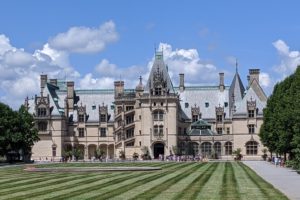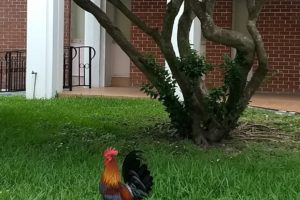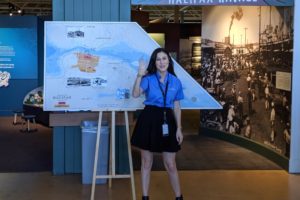Have you ever noticed that no two battles of any war are the same? We’ve heard military people say that the best plans fall apart with the first shot. The 2 battles of Fort Fisher in late December 1864 and mid-January 1865 were about as different as they could be, but at least the North learned from their first failure. Since I’m a planner at heart, this look at history drew me in. Come learn about the unknown battle that ensured the end of the Civil War because the North cut off the supply lines of the South that had been fed by the blockade-runners.
The Union’s determination to close the last open Southern port of Wilmington meant that Fort Fisher had to be captured. In December 1864, Union army and naval forces gathered 64 warships that mounted 619 guns that could fire 20,000 shells. This would be the largest naval bombardment of the war up to that time.
1st battle

At around 1:40 a.m. on Christmas Eve morning, the USS Louisiana, a powder boat carrying 215 tons of black powder, purposely exploded within 600 yards of the northeast part of the fort. General Butler was convinced that the blast would destroy the fort in that area, but it was a dismal failure.

Then 2700 Federal troops of the 6500-man army force disembarked to attack the fort’s land face. But they soon had to return to their ships because of bad weather, poor coordination between naval and army officers, and concerns about an outcome similar to a recent attack on Battery Wagner close to Charleston, SC.

The fleet map of the first bombardment on Fort Fisher gave the Union soldiers and sailors confidence. Most of the long side of the fort’s “L” side is now underwater in the Atlantic Ocean, and divers now love to explore what’s there.

2nd battle
The Federal battle plan now was for 1600 sailors and 400 marines to attack the fort’s sea face; at the same time, 3700 troops were to come in by land. Here’s what the admiral said of his play: “The sailors will be armed with cutlasses [a short-bladed slashing sword], well sharpened and with revolvers . . . and board the fort on the run in a seaman-like way. The marines will form in the rear and cover the sailors . . . .”
My Marine husband is aghast that Marines would follow the sailors into battle so I looked up the role of the Marine Corps during the Civil War. Here’s what I found. Why Marines in the Civil War Were so Under-Prepared. “The armed services were ill-prepared for the magnitude of the conflict, and none more so than the Marines in the Civil War. In 1861, the Corps’ total strength numbered just 63 officers and 1,712 enlisted personnel.” Glad they learned their lesson and upped their numbers and skills.
Barney said that in most of their early history, they were the sharpshooters in the rigging of the sailing ships during naval battles.

Remember in the previous post we learned that a mile of trees were cut down in front of the fort so Confederate soldiers could see what fighting force was coming at them?


The Union’s plan of attack is laid out on the following map. You can see the sailors were to attack in three places (left side of map) followed by the Marines. The infantry would then attack Shepherd’s Battery (2 mounds of ground that held Confederate cannons and protected men) on the other side of the land face, entering the rear area of the fort through the Bloody Gate that we’ll learn about in this post.


The 2nd battle at Fort Fisher started on January 13, 1865, and lasted for 2 days. The signal for the infantry to start their assault was made at 3:25 p.m. General Ames described what happened: “My three brigades were in line, one behind the other, ranging from three to five hundred yards from the fort. The left of each line nearly opposite the middle of the land face of the fort, the right near the river . . .


Once the first brigade had a foothold, the second brigade joined the battle. The Union forces broke through the stockade fence and climbed up the side of Shepherd’s Battery. Fierce hand-to-hand combat took place within the first 3 gun traverses (a mass of earth or other material employed to protect troops against attacks. It is constructed at right angles to the protective mounds manned by the defenders, and is far enough to the rear to give the protection required by the circumstances.)


While the Union soldiers were advancing, the naval bombardment created a few openings in the stockade but they were not large enough for a quick passage. Curtis’ brigade used axes to make the openings bigger.


Capt. Lawrence was the first through the palisade and wanted to plant his unit’s flag on the first traverse (mound), but his hand was shot away, and he was mortally wounded in the neck.

The Union soldiers found 2 Columbiads (a large-caliber, smoothbore, muzzle-loading cannon able to fire heavy projectiles at both high and low trajectories); one was disabled and the enemy was loading the other one. After surrender was demanded, “the man at the breech put out his hand to discharge the cannon. A sharp blow from a saber on his outstretched hand quickly dissuaded him.”

Why was this entrance to the fort at this location, the extreme west end of Fort Fisher’s land face next to the Cape Fear River? While it’s in a marshy area close to the river, where it was challenging to build effective defenses against attack, it was the end point of the only road leading north to Wilmington (remember the River Road picture?).
The gate was protected by abatis (an obstacle formed of the branches of trees laid in a row, with the sharpened tops directed outwards, towards the enemy. The trees are usually interlaced or tied with wire) and palisades (vertical row of trees with sharpened tops), and was overlooked by Shepherd’s Battery just above it.

The Confederates thought this gate was secure.

So what happened to those fighting the Union soldiers? Capt. Braddy from North Carolina said only half of his men were at this section of the fort at the time of the attack. He had no idea what was happening elsewhere with other forces.

So a lack of communication.

defending Wilmington
After Charleston, Wilmington was the most fortified city in the South. It was the hub of a vital transportation network that included 3 railroads and the Cape Fear River. Protecting that network meant that a defensive strategy had to be set up.

When both entrances to the river were heavily defended, the engineers then supplemented the defenses with heavy artillery batteries and entrenchments around the city, as well as torpedoes and obstructions in the Cape Fear River.

In Wilmington, “the wharves were filled with provisions, clothing and ordnance. The RR depots are choked with supplies.” Gen. Whiting wrote this description on May 3, 1864, just 6 months before the first battle at Fort Fisher.

This railroad ran into Virginia, bringing much needed war material to Gen. Lee’s armies. Lee wrote in late 1864 that “If Wilmington falls, I cannot maintain my army.” When his supply line was cut off by the Union taking over Fort Fisher in January 1865, the Confederacy was doomed.

The area Barney was looking at in the last picture was the scene of the hottest fighting within the fort on January 15, 1865. Union flags floating above Shepherd’s Battery to the left of where Barney is prompted Gen Whiting to call for a counterattack. He wanted his men to “pull down those flags and drive the enemy from the works.”

Word was sent to gunners to start shooting, and they turned their guns to fire inside the fort, killing and wounding their own and the enemy. With Union forces advancing, friendly fire became an issue.



The first battle of Fort Fisher on December Eve morning resulted in a Confederate victory and a Union defeat. But the second battle was a different story. When Fort Fisher fell after a massive Federal amphibious and land assault on January 15, 1865, (only a 2-day battle) its defeat helped seal the fate of the Confederacy because its supply lines were entirely cut off.
After hours of battle, the Confederates surrendered the fort. The Southern defenses around Wilmington crumbled, and the city fell to Union soldiers roughly one month later. The last Confederate port was locked shut, and the flow of outside supplies ceased to reach the Confederate field armies. Surrender was in sight.
So what was the loss of men on both sides:
- South had 500 men killed and wounded and 1400 captured
- North had a total of 393 men killed, wounded, and missing
more on building the fort
As we’ve said, Fort Fisher was an earthen fortification since artillery being used at this time would go right through masonry forts used earlier in the 1800s. Also, this fort was the largest ever built by the Confederacy; it spanned more than 1.5 miles and was shaped like the number “7” (elsewhere the description was an “L”).
As it was being built, on any given day for 2.5 years, around 1000 men, both enslaved laborers and soldiers stationed here, worked together on the project.

Heavy seacoast guns, such as those used here, were placed on their carriages using a gin like the one in the following picture.

The following drawing is of Fort Fisher from 1863.

When the Confederate leaders heard about the fall of Fort Fisher, they dismantled and abandoned 4 other forts around the mouth of the river and assembled their troops at Fort Anderson, closer to Wilmington, to prepare for attack.
The Union planned another army/navy assault and bombarded Fort Anderson for 2 days before the Confederates withdrew closer to Wilmington. Union troops entered the abandoned fort on February 19, 1865. The Federal army then started toward Wilmington, and residents prepared for the inevitable.

While Wilmington was captured, Union troops continued to occupy Fort Fisher and Federal Point under a military occupation policy.

The post commander said in April 1865, “the bursting of 10 inch Columbiads while firing a salute in honor of the restoration of the old flat on Sumpter [sic] killing two men of the 2nd Pa. Heavy Artillery.”
Right after Fort Fisher fell in January 1865, well known Civil War photographer Timothy O’Sullivan visited the fort and photographed the mass destruction that happened here.

But this wasn’t the end of Federal Point. It was even used during as a training base during WWII.

We’ve learned so much and my head is full as I’ve tried to figure out what happened during these 2 battles that were so important to ending the Civil War. I’m glad to have the opportunity to understand the what was behind these important but unknown battles.
Now onto Charleston and our first RV stay in South Carolina.




